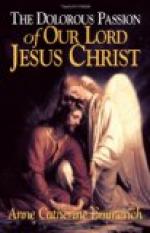’The signification of my sufferings in all my limbs was explained to me in the following vision: I saw a gigantic human body in a horrible state of mutilation, and raised upwards towards the sky. There were no fingers or toes on the hands and feet, the body was covered with frightful wounds, some of which were fresh and bleeding, others covered with dead flesh or turned into excrescences. The whole of one side was black, gangrened, and as it were half eaten away. I suffered as though it had been my own body that was in this state, and then my guide said to me “This is the body of the Church, the body of all men and thine also.” Then, pointing to each wound, he showed me at the same time some part of the world; I saw an infinite number of men and nations separated from the Church, all in their own peculiar way, and I felt pain as exquisite from this separation as if they had been torn from my body. Then my guide said to me: “Let thy sufferings teach thee a lesson, and offer them to God in union with those of Jesus for all who are separated. Should not one member call upon another, and suffer in order to cure and unite it once more to the body? When those parts which are most closely united to the body detach themselves, it is as though the flesh were torn from around the heart.” In my ignorance, I thought that he was speaking of those brethren who are not in communion with us, but my guide added: “Who are our brethren? It is not our blood relations who are the nearest to our hearts, but those who are our brethren in the blood of Christ—the children of the Church who fall away.” He showed me that the black and gangrened side of the body would soon be cured; that the putrefied flesh which had collected around the wounds represented heretics who divide one from the other in proportion as they increase; that the dead flesh was the figure of all who are spiritually dead, and who are void of any feeling; and that the ossified parts represented obstinate and hardened heretics. I saw and felt in this manner every wound and its signification. The body reached up to heaven. It was the body of the Bride of Christ, and most painful to behold. I wept bitterly, but feeling at once deeply grieved and strengthened by sorrow and compassion, I began again to labour with all my strength.’




